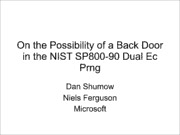
15-shumow.pdf (PDFy mirror) PDF
Preview 15-shumow.pdf (PDFy mirror)
On the Possibility of a Back Door in the NIST SP800-90 Dual Ec Prng Dan Shumow Niels Ferguson Microsoft The Dual Ec PRNG • φ : prime curve → integers φ (x,y) = x • P, Q points on the curve (per SP800-90) φ(r *P) i s i+1 s φ r φ(r *Q) t LSB (t ) i i i i bitlen-16 i (s *P) i Equations: r = φ(s *P) t = φ(r *Q) s = φ(r *P) i i i i i+1 i The Objection • Point P is generator of the curve (per SP800-90). • Point Q is a specified constant. It is not stated how it was derived. • NIST prime curves have prime order. So there exists e such that Qe = P. The Attack • Output: S, the set of possible values of s the internal i+1 state of the Dual Ec PRNG at the subsequent step. • Suppose an attacker knows value e. Given: a block of output o from a Dual EC PRNG i Instance Set S = {}. For 0 ≤ u ≤ 216 −1 x = u|o i z (cid:15495) x3 + ax + b mod p. If y (cid:15495) z1/2 mod p exists => A = (x,y) is on the curve S = S U {φ(e*A)}. How this works: One of the values x = t • i If A is the point with x coordinate t then: i A = r * Q i Thus: φ(e*A) = φ(e* r * Q) = φ(r * P) = s . i i i+1 => s is in S. i+1 • |S| ≈ 215 Experimental Verification 1. Pick NIST P-256 Curve 2. Chose random d 3. Chose Q = d*P 2 4. Replace Q with Q 2 5. Given |Output| = 32 > out block length 6. Filter out s values that do not generate next i+1 2 bytes. In every experiment 32 bytes of output was sufficient to uniquely identify the internal state of the PRNG. The Main Point • If an attacker knows d such that d*P = Q then they can easily compute e such that e*Q = P (invert mod group order) • If an attacker knows e then they can determine a small number of possibilities for the internal state of the Dual Ec PRNG and predict future outputs. • We do not know how the point Q was chosen, so we don’t know if the algorithm designer knows d or e. Conclusion • WHAT WE ARE NOT SAYING: NIST intentionally put a back door in this PRNG • WHAT WE ARE SAYING: The prediction resistance of this PRNG (as presented in NIST SP800-90) is dependent on solving one instance of the elliptic curve discrete log problem. (And we do not know if the algorithm designer knew this before hand.) Suggestions for Improvement • Truncate off more than the top 16 bits of the output block. – Results on extractors from x coordinates of EC points of prime curves suggest truncating off the top bitlen/2 bits is reasonable. • Generate a random point Q for each instance of the PRNG.
